Edelstein-Keshet L. Mathematical Models in Biology
Подождите немного. Документ загружается.

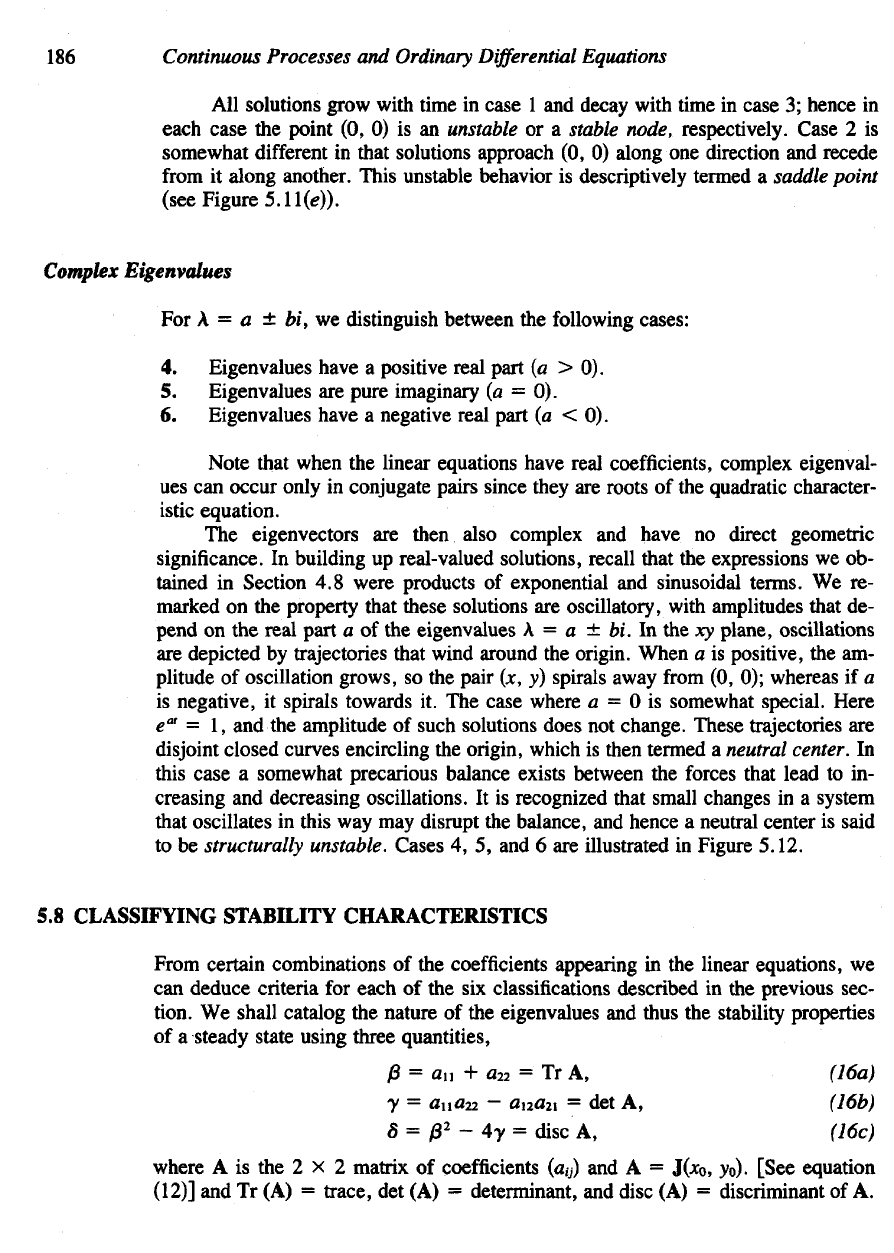
186
Continuous Processes
and
Ordinary
Differential
Equations
All
solutions grow with time
in
case
1 and
decay with time
in
case
3;
hence
in
each
case
the
point
(0, 0) is an
unstable
or a
stable
node, respectively. Case
2 is
somewhat
different
in
that solutions approach
(0, 0)
along
one
direction
and
recede
from
it
along another. This unstable behavior
is
descriptively termed
a
saddle
point
(see Figure 5.11
(e)).
Complex
Eigenvalues
For A = a ± hi, we
distinguish between
the
following
cases:
4.
Eigenvalues have
a
positive real part
(a > 0).
5.
Eigenvalues
are
pure imaginary
(a = 0).
6.
Eigenvalues have
a
negative real part
(a < 0).
Note that
when
the
linear equations have real
coefficients,
complex eigenval-
ues can
occur only
in
conjugate pairs since they
are
roots
of the
quadratic character-
istic
equation.
The
eigenvectors
are
then also complex
and
have
no
direct geometric
significance.
In
building
up
real-valued solutions, recall that
the
expressions
we ob-
tained
in
Section
4.8
were products
of
exponential
and
sinusoidal terms.
We re-
marked
on the
property that these solutions
are
oscillatory,
with
amplitudes that
de-
pend
on the
real
part
a of the
eigenvalues
A = a ± bi. In the xy
plane,
oscillations
are
depicted
by
trajectories that wind around
the
origin. When
a is
positive,
the am-
plitude
of
oscillation grows,
so the
pair
(x, v)
spirals away
from
(0, 0);
whereas
if a
is
negative,
it
spirals towards
it. The
case where
a = 0 is
somewhat
special.
Here
e" = 1, and the
amplitude
of
such solutions does
not
change. These trajectories
are
disjoint
closed curves encircling
the
origin, which
is
then termed
a
neutral center.
In
this
case
a
somewhat precarious balance exists between
the
forces that lead
to in-
creasing
and
decreasing oscillations.
It is
recognized that small changes
in a
system
that
oscillates
in
this
way may
disrupt
the
balance,
and
hence
a
neutral center
is
said
to be
structurally unstable. Cases
4, 5, and 6 are
illustrated
in
Figure 5.12.
5.8
CLASSIFYING STABILITY CHARACTERISTICS
From certain combinations
of the
coefficients
appearing
in the
linear equations,
we
can
deduce
criteria
for
each
of the six
classifications
described
in the
previous
sec-
tion.
We
shall catalog
the
nature
of the
eigenvalues
and
thus
the
stability properties
of
a
steady state using three quantities,
where
A is the 2 x 2
matrix
of
coefficients (a/,)
and A =
J(;to,
yo)-
[See equation
(12)]
and Tr (A) =
trace,
del (A) =
determinant,
and
disc
(A) =
discriminant
of A.
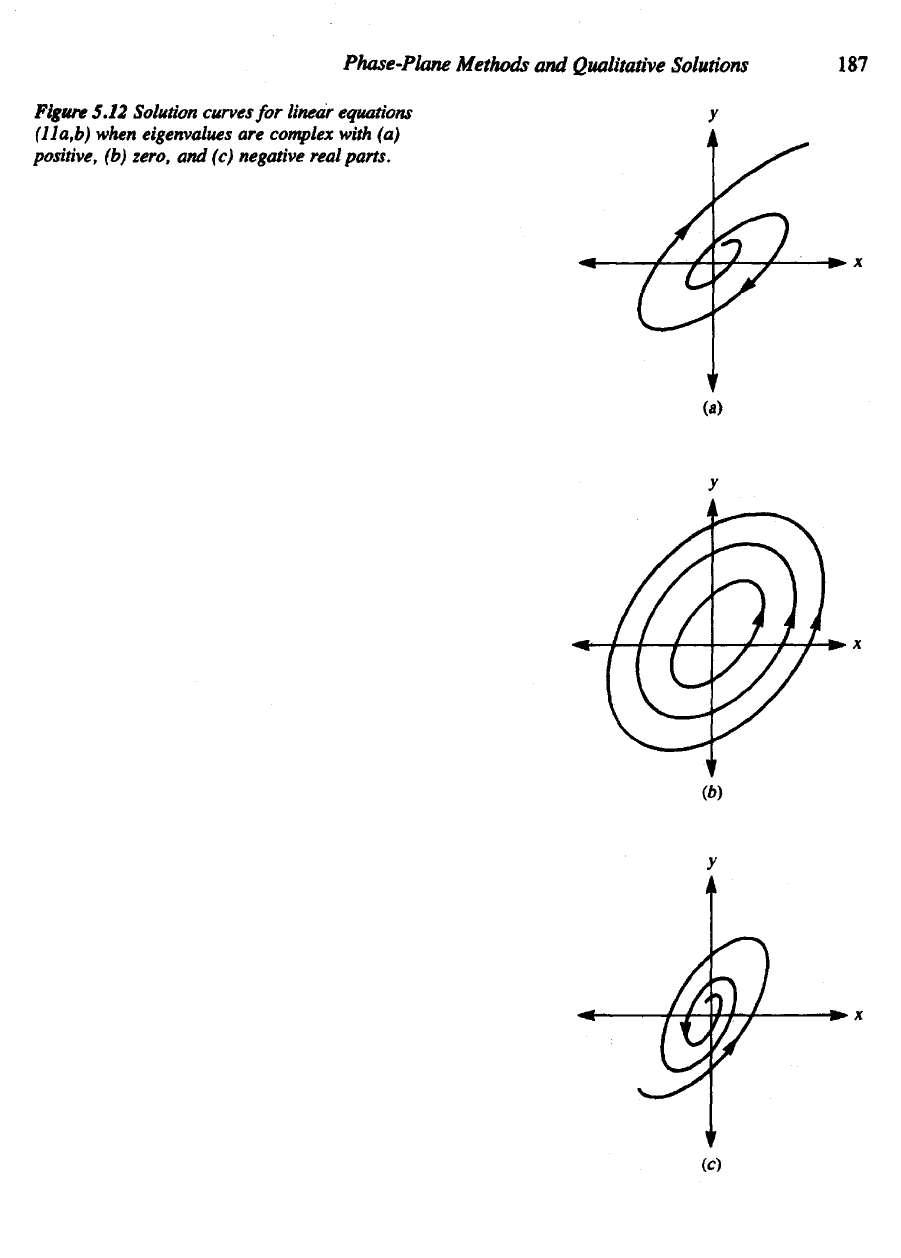
Phase-Plane Methods
and
Qualitative Solutions
187
Figure
5.12
Solution curves
for
linear equations
(lla,b)
when eigenvalues
are
complex with
(a)
positive,
(b)
zero,
and (c)
negative real
parts.
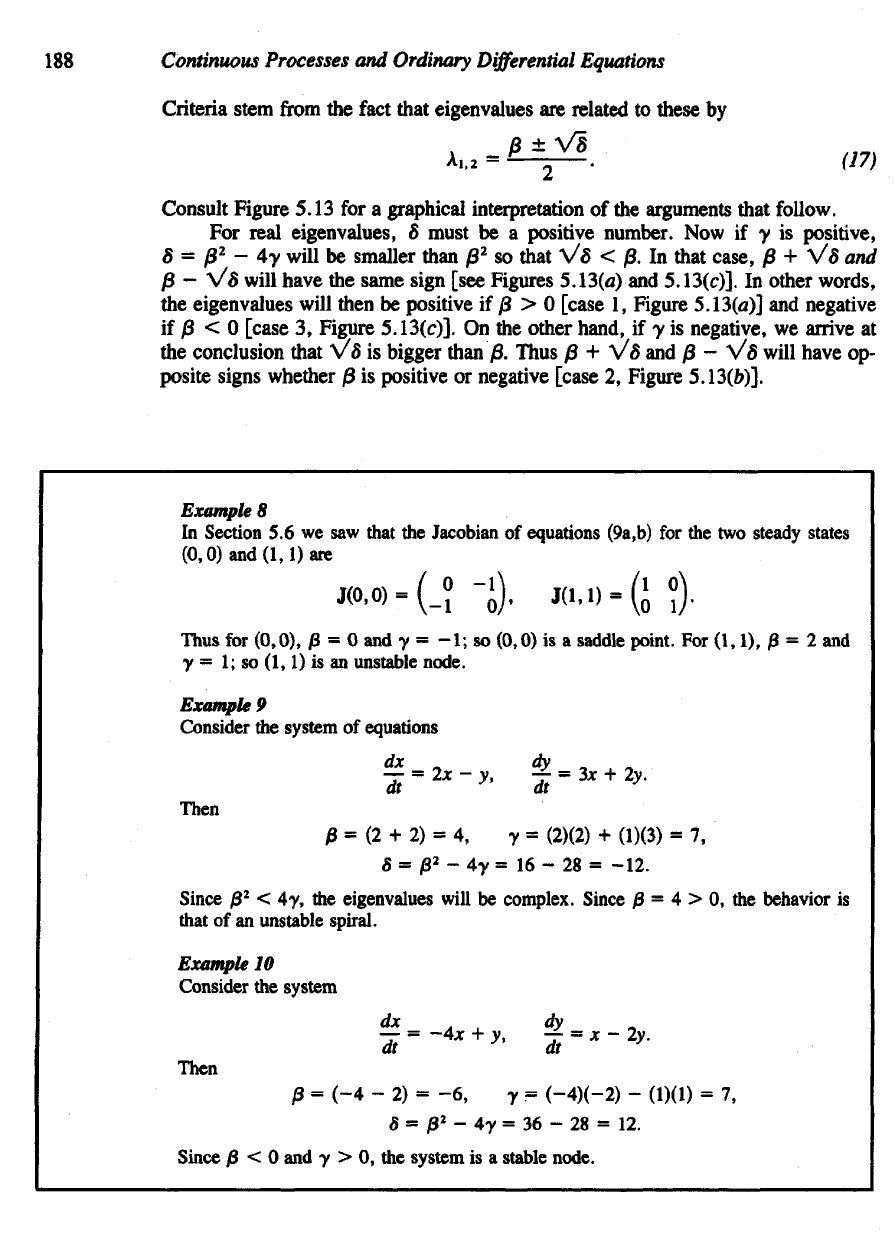
188
Continuous Processes
and
Ordinary
Differential
Equations
Criteria stem
from
the
fact
that eigenvalues
are
related
to
these
by
Example
8
In
Section
5.6 we saw
that
the
Jacobian
of
equations (9a,b)
for the two
steady states
(0,0)
and
(1,1)
are
Example
10
Consider
the
system
Consult
Figure 5.13
for a
graphical interpretation
of the
arguments that follow.
For
real eigenvalues,
8
must
be a
positive number.
Now if y is
positive,
5 = )3
2
- 4y
will
be
smaller than
/3
2
so
that
V5 < 0. In
that case,
£ + Vfi
and
ft - V5
will have
the
same sign [see Figures 5.13(a)
and
5.13(c)].
In
other words,
the
eigenvalues will then
be
positive
if j8 > 0
[case
1,
Figure
5.13(a)]
and
negative
if
ft < 0
[case
3,
Figure
5.13(c)].
On the
other hand,
if y is
negative,
we
arrive
at
the
conclusion that
V8 is
bigger
than
)3.
Thus
ft + V8 and ft - X/S
will
have
op-
posite
signs whether
/3 is
positive
or
negative
[case
2,
Figure
5.13(fc)].
Thus
for
(0,0),
j8 = 0 and y = -1; so
(0,0)
is a
saddle point.
For
(1,1),
0 - 2 and
y — 1; so
(1,1)
is an
unstable node.
Example
9
Consider
the
system
of
equations
Then
Since
/3
2
< 4% the
eigenvalues will
be
complex. Since
/3 = 4 > 0, the
behavior
is
that
of an
unstable spiral.
Then
iince
JB
< U and y > 0, the
system
is a
stable node.
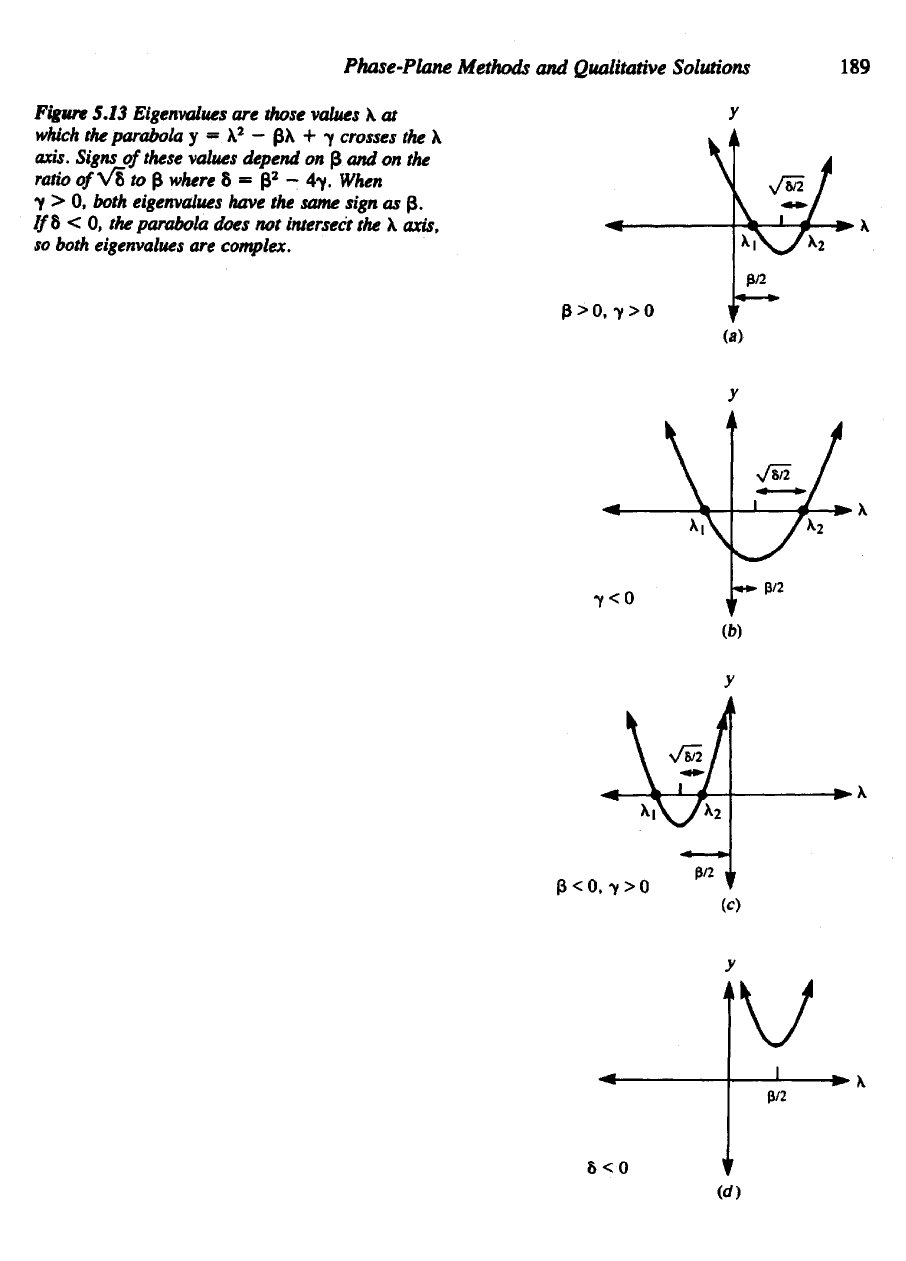
Phase-Plane
Methods
and
Qualitative Solutions
189
Figure
5.13
Eigenvalues
are
those values
X at
which
the
parabola
y
—
X
2
-
(5X
+ y
crosses
the X
axis.
Signs
of
these values depend
on (3 and on the
ratio
ofVEtofr
where
8 = p
2
- 47.
When
y
> 0,
both eigenvalues have
the
same sign
as (5.
If
8 < 0, the
parabola does
not
intersect
the X
axis,
so
both eigenvalues
are
complex.
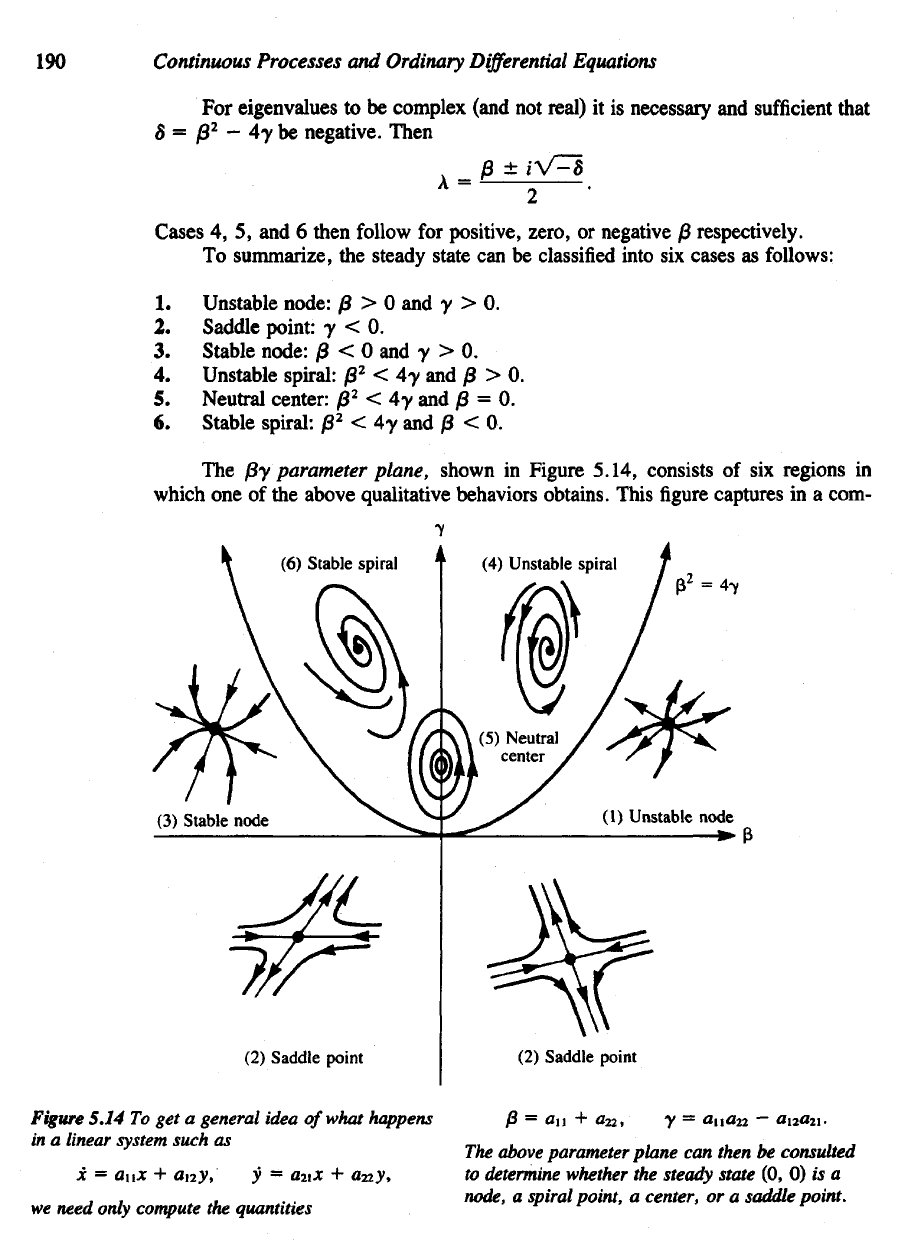
190
Continuous
Processes
and
Ordinary
Differential
Equations
Figure
5.14
To get a
general idea
of
what happens
in
a
linear system such
as
x
= flu* +
any,
y =
azix
+
a^y,
we
need only compute
the
quantities
The
above parameter
plane
can
then
be
consulted
to
determine whether
the
steady state
(0, 0) is a
node,
a
spiral
point,
a
center,
or a
saddle
point.
For
eigenvalues
to be
complex (and
not
real)
it is
necessary
and
sufficient
that
5
= j3
2
- 4y be
negative. Then
Cases
4, 5, and 6
then follow
for
positive, zero,
or
negative
)3
respectively.
To
summarize,
the
steady state
can be
classified
into
six
cases
as
follows:
1.
Unstable node:
{3 > 0 and y > 0.
2.
Saddle point:
y < 0.
3.
Stable node:
/3 < 0 and y > 0.
4.
Unstable spiral:
0
2
<
4-y
and /3 > 0.
5.
Neutral center:
/8
2
< 4y and /3 = 0.
6.
Stable
spiral:
j8
2
< 4y and 0 < 0.
The @y
parameter plane,
shown
in
Figure 5.14, consists
of six
regions
in
which
one of the
above qualitative behaviors obtains. This
figure
captures
in a
com-
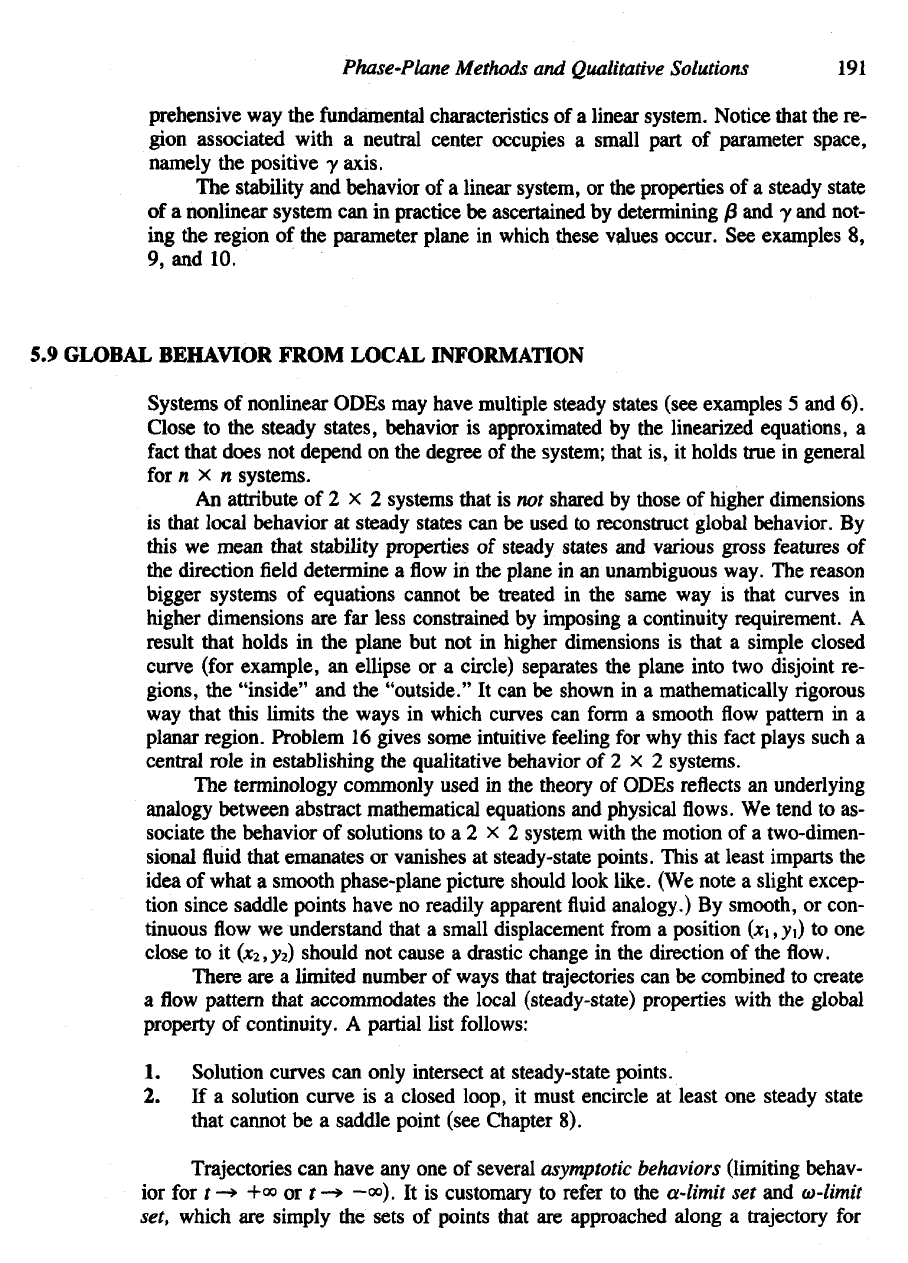
Phase-Plane
Methods
and
Qualitative
Solutions
191
prehensive
way the
fundamental characteristics
of a
linear system. Notice that
the re-
gion
associated
with
a
neutral center occupies
a
small part
of
parameter space,
namely
the
positive
y
axis.
The
stability
and
behavior
of a
linear system,
or the
properties
of a
steady state
of
a
nonlinear system
can in
practice
be
ascertained
by
determining
fi and y and
not-
ing
the
region
of the
parameter plane
in
which
these values occur.
See
examples
8,
9, and 10.
5.9
GLOBAL BEHAVIOR FROM LOCAL INFORMATION
Systems
of
nonlinear ODEs
may
have multiple steady states (see examples
5 and 6).
Close
to the
steady states, behavior
is
approximated
by the
linearized equations,
a
fact
that does
not
depend
on the
degree
of the
system; that
is, it
holds true
in
general
for
n x n
systems.
An
attribute
of 2 x 2
systems that
is not
shared
by
those
of
higher dimensions
is
that
local
behavior
at
steady states
can be
used
to
reconstruct global behavior.
By
this
we
mean that stability properties
of
steady states
and
various gross features
of
the
direction
field
determine
a flow in the
plane
in an
unambiguous way.
The
reason
bigger systems
of
equations cannot
be
treated
in the
same
way is
that curves
in
higher dimensions
are far
less constrained
by
imposing
a
continuity requirement.
A
result that holds
in the
plane
but not in
higher dimensions
is
that
a
simple closed
curve
(for example,
an
ellipse
or a
circle) separates
the
plane into
two
disjoint
re-
gions,
the
"inside"
and the
"outside."
It can be
shown
in a
mathematically
rigorous
way
that this limits
the
ways
in
which curves
can
form
a
smooth
flow
pattern
in a
planar
region.
Problem
16
gives some intuitive feeling
for why
this
fact
plays such
a
central
role
in
establishing
the
qualitative behavior
of 2 x 2
systems.
The
terminology commonly used
in the
theory
of
ODEs reflects
an
underlying
analogy between abstract mathematical equations
and
physical
flows. We
tend
to as-
sociate
the
behavior
of
solutions
to a 2 x 2
system with
the
motion
of a
two-dimen-
sional
fluid
that emanates
or
vanishes
at
steady-state points. This
at
least imparts
the
idea
of
what
a
smooth phase-plane picture should look like.
(We
note
a
slight excep-
tion
since saddle points have
no
readily apparent
fluid
analogy.)
By
smooth,
or
con-
tinuous
flow we
understand that
a
small displacement
from
a
position
(jci,
yO to one
close
to it
(*2,y2)
should
not
cause
a
drastic change
in the
direction
of the flow.
There
are a
limited
number
of
ways that trajectories
can be
combined
to
create
a flow
pattern that accommodates
the
local (steady-state) properties with
the
global
property
of
continuity.
A
partial
list
follows:
1.
Solution curves
can
only intersect
at
steady-state points.
2. If a
solution curve
is a
closed loop,
it
must encircle
at
least
one
steady state
that
cannot
be a
saddle point (see Chapter
8).
Trajectories
can
have
any one of
several
asymptotic
behaviors
(limiting behav-
ior for t
—»
+°o or t
—»
—o°).
It is
customary
to
refer
to the
a-limit
set and
w-limit
set,
which
are
simply
the
sets
of
points that
are
approached along
a
trajectory
for
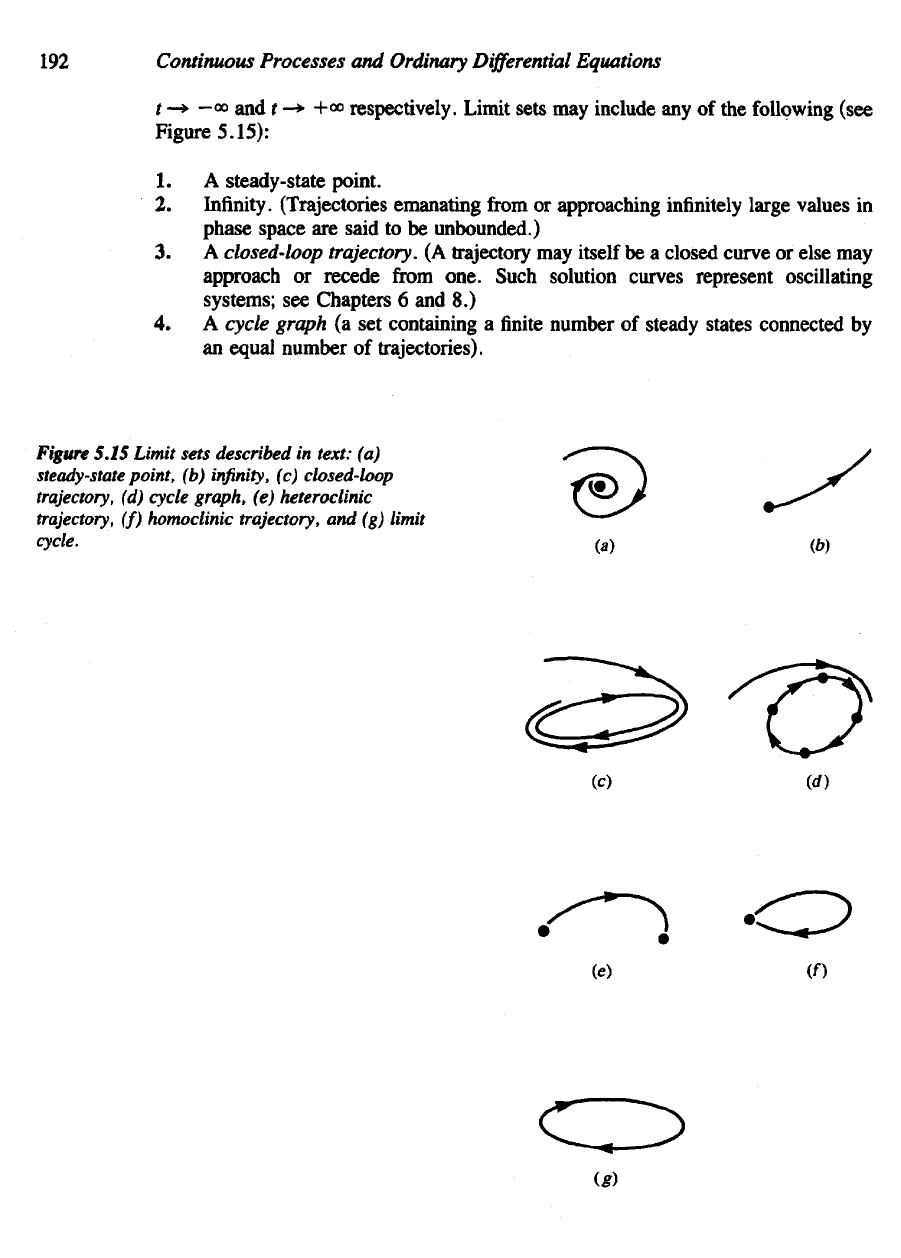
192
Continuous
Processes
and
Ordinary
Differential
Equations
t
—»
-oo and t
—»
+00 respectively.
Limit
sets
may
include
any of the
following (see
Figure
5.15):
1. A
steady-state point.
2.
Infinity. (Trajectories emanating
from
or
approaching infinitely large values
in
phase space
are
said
to be
unbounded.)
3. A
closed-loop
trajectory.
(A
trajectory
may
itself
be a
closed curve
or
else
may
approach
or
recede
from
one. Such solution curves represent oscillating
systems;
see
Chapters
6 and 8.)
4. A
cycle
graph
(a set
containing
a
finite
number
of
steady states connected
by
an
equal number
of
trajectories).
Figure
5.15 Limit sets described
in
text:
(a)
steady-state
point,
(b)
infinity,
(c)
closed-loop
trajectory,
(d)
cycle
graph,
(e)
heteroclinic
trajectory,
(f)
homoclinic
trajectory,
and (g)
limit
cycle.
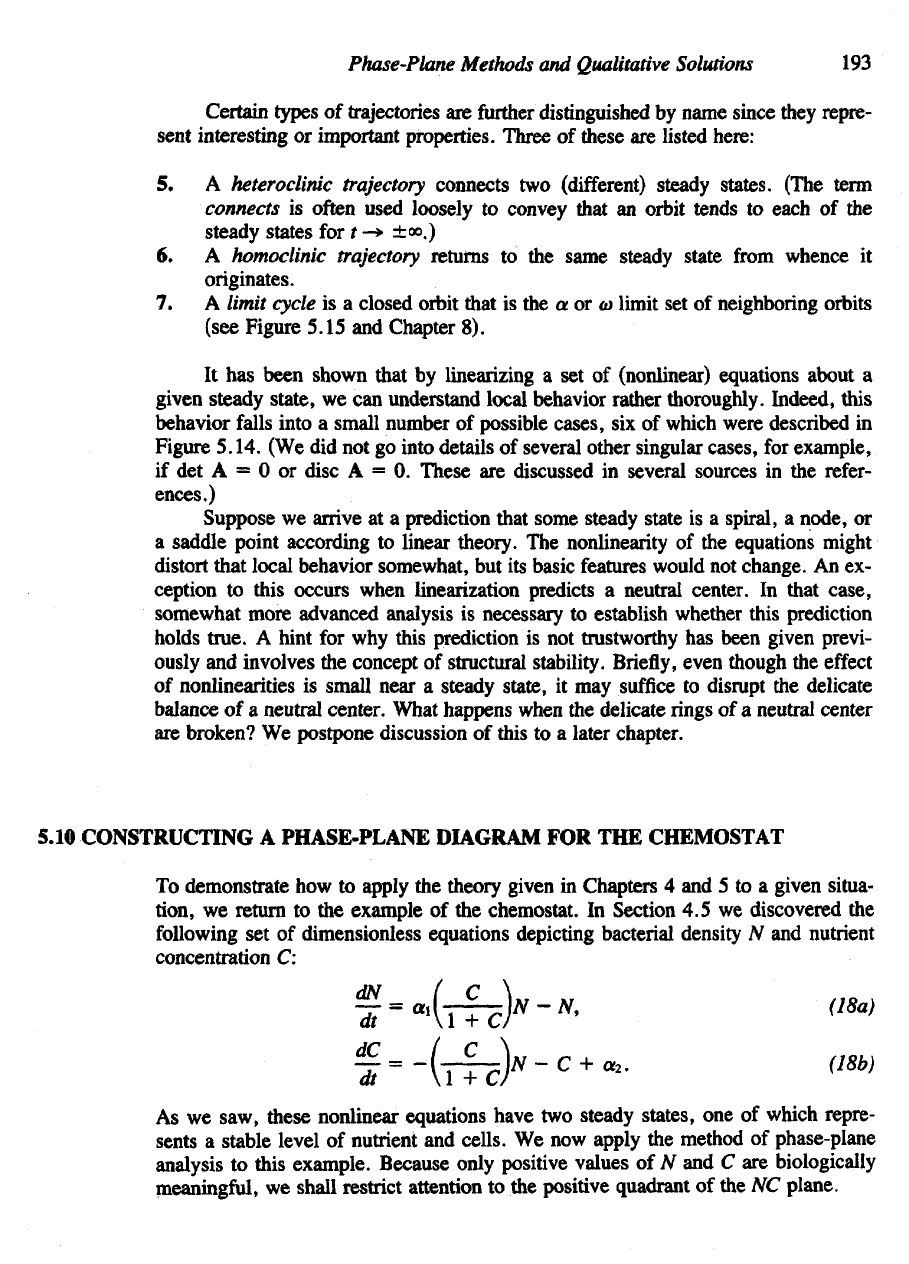
Phase-Plane
Methods
and
Qualitative
Solutions
193
Certain types
of
trajectories
are
further
distinguished
by
name since they repre-
sent interesting
or
important properties. Three
of
these
are
listed here:
5. A
heteroclinic
trajectory
connects
two
(different)
steady states. (The term
connects
is
often
used
loosely
to
convey that
an
orbit tends
to
each
of the
steady states
for t -»
±<».)
6. A
homoclinic
trajectory
returns
to the
same steady state
from
whence
it
originates.
7. A
limit
cycle
is a
closed orbit that
is the a or a)
limit
set of
neighboring orbits
(see Figure 5.15
and
Chapter
8).
It has
been shown that
by
linearizing
a set of
(nonlinear) equations about
a
given
steady state,
we can
understand local behavior rather thoroughly. Indeed, this
behavior
falls
into
a
small number
of
possible cases,
six of
which
were described
in
Figure 5.14.
(We did not go
into details
of
several other singular cases,
for
example,
if
det A = 0 or
disc
A = 0.
These
are
discussed
in
several sources
in the
refer-
ences.)
Suppose
we
arrive
at a
prediction
that
some steady state
is a
spiral,
a
node,
or
a
saddle point according
to
linear theory.
The
nonlinearity
of the
equations might
distort that local behavior somewhat,
but its
basic
features
would
not
change.
An ex-
ception
to
this occurs when linearization predicts
a
neutral center.
In
that case,
somewhat more advanced analysis
is
necessary
to
establish whether this prediction
holds true.
A
hint
for why
this prediction
is not
trustworthy
has
been given previ-
ously
and
involves
the
concept
of
structural stability.
Briefly,
even though
the
effect
of
nonlinear!ties
is
small near
a
steady state,
it may
suffice
to
disrupt
the
delicate
balance
of a
neutral center. What happens when
the
delicate
rings of a
neutral center
are
broken?
We
postpone discussion
of
this
to a
later chapter.
5.10 CONSTRUCTING
A
PHASE-PLANE DIAGRAM
FOR THE
CHEMOSTAT
To
demonstrate
how to
apply
the
theory given
in
Chapters
4 and 5 to a
given situa-
tion,
we
return
to the
example
of the
chemostat.
In
Section
4.5 we
discovered
the
following
set of
dimensionless equations depicting bacterial density
N and
nutrient
concentration
C:
As
we
saw, these nonlinear equations have
two
steady states,
one of
which repre-
sents
a
stable level
of
nutrient
and
cells.
We now
apply
the
method
of
phase-plane
analysis
to
this example. Because only positive values
of N and C are
biologically
meaningful,
we
shall
restrict attention
to the
positive quadrant
of the NC
plane.
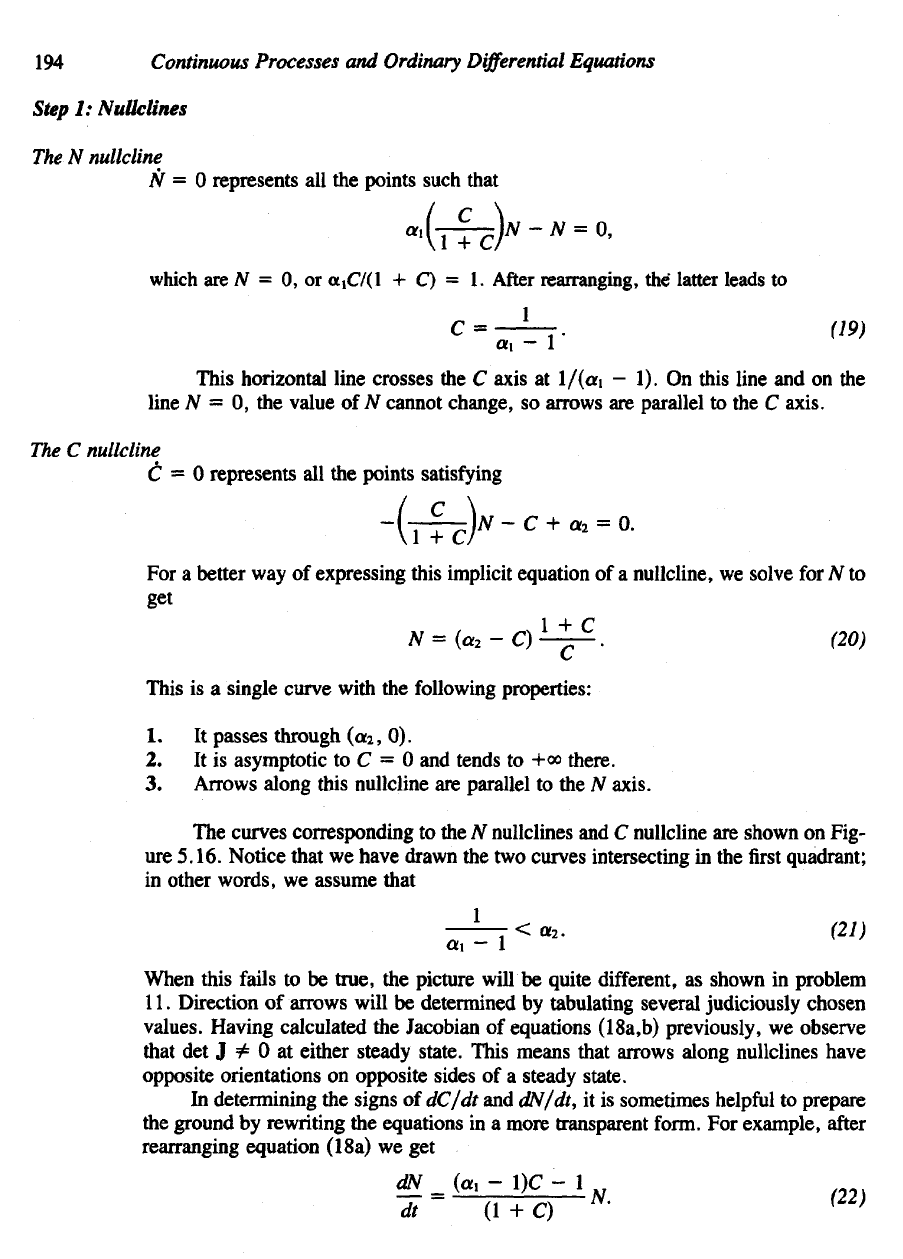
194
Continuous Processes
and
Ordinary
Differential
Equations
Step
1:
Nuttclines
The
N
nullcline
N
= 0
represents
all the
points such that
which
are N = 0, or
aiC/(l
+ C) = 1.
After
rearranging,
the
latter leads
to
This
horizontal line crosses
the C
axis
at
\/(a\
- 1). On
this line
and on the
line
N = 0, the
value
of N
cannot change,
so
arrows
are
parallel
to the C
axis.
The
C
nullcline
C
= 0
represents
all the
points satisfying
For a
better
way of
expressing this implicit equation
of a
nullcline,
we
solve
for N to
Oftt
This
is a
single curve with
the
following
properties:
1. It
passes
through («
2
,
0).
2. It is
asymptotic
to C = 0 and
tends
to
+«>
there.
3.
Arrows along this nullcline
are
parallel
to the N
axis.
The
curves corresponding
to the N
nullclines
and C
nullcline
are
shown
on
Fig-
ure
5.16. Notice that
we
have drawn
the two
curves intersecting
in the first
quadrant;
in
other words,
we
assume that
When
this fails
to be
true,
the
picture will
be
quite
different,
as
shown
in
problem
11.
Direction
of
arrows will
be
determined
by
tabulating several judiciously chosen
values.
Having calculated
the
Jacobian
of
equations (18a,b) previously,
we
observe
that
det J
=£
0 at
either steady state. This means that arrows along nullclines have
opposite
orientations
on
opposite
sides
of a
steady state.
In
determining
the
signs
of
dC/dt
and
dN/dt,
it is
sometimes
helpful
to
prepare
the
ground
by
rewriting
the
equations
in a
more transparent form.
For
example,
after
rearranging equation (18a)
we get
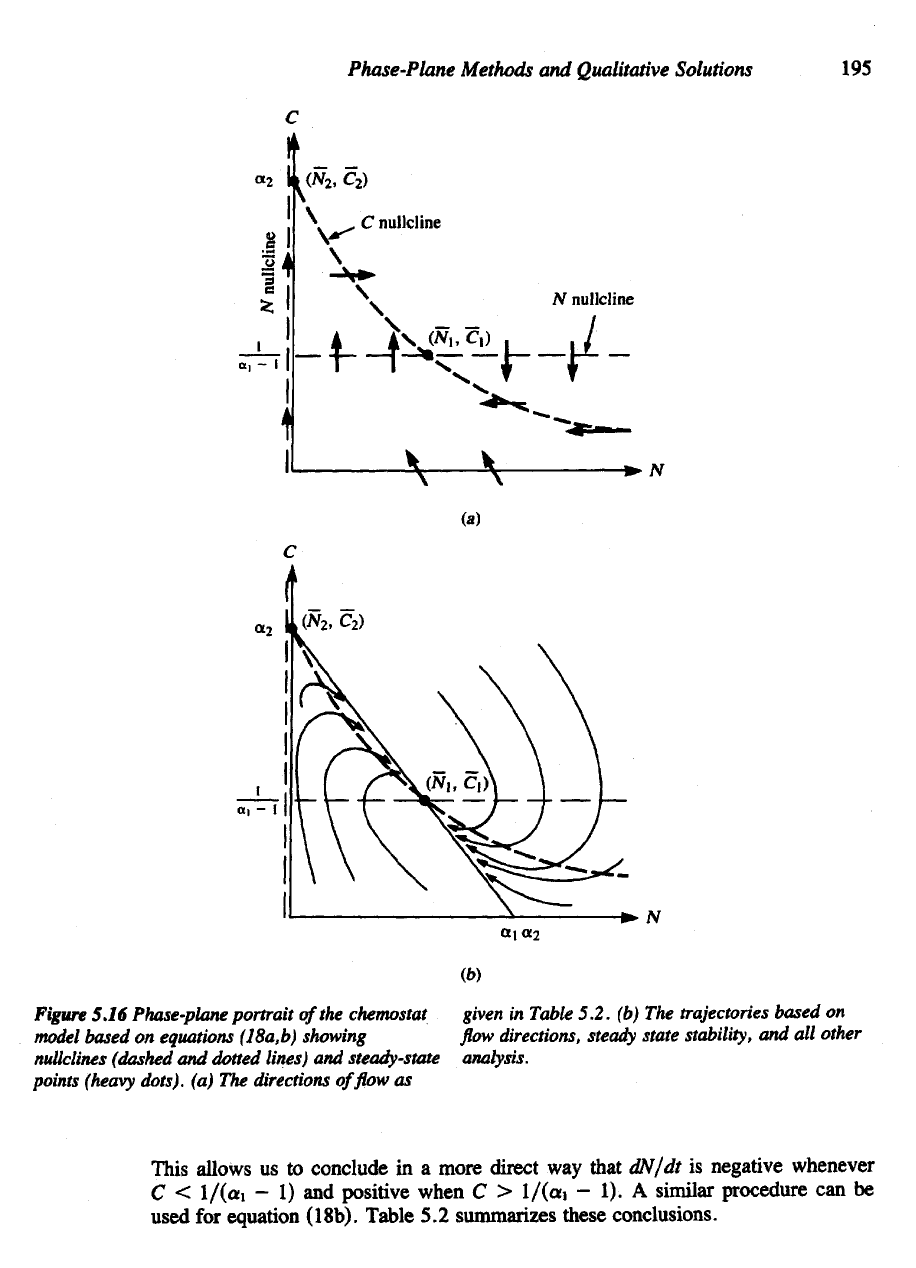
Phase-Plane Methods
and
Qualitative Solutions
195
Figure 5.16 Phase-plane
portrait
of
the
chemostat given
in
Table 5.2.
(b) The
trajectories based
on
model
based
on
equations (18a,b) showing
flowdirections, steady state stability,
and all
other
nullclines (dashed
and
dotted lines)
and
steady-state analysis,
points
(heavy
dots),
(a) The
directions
of flow as
This allows
us to
conclude
in a
more direct
way
that
dN/dt
is
negative whenever
C
<
l/(«i
- 1) and
positive when
C >
l/(«i
- 1). A
similar procedure
can be
used
for
equation (18b). Table
5.2
summarizes these conclusions.
